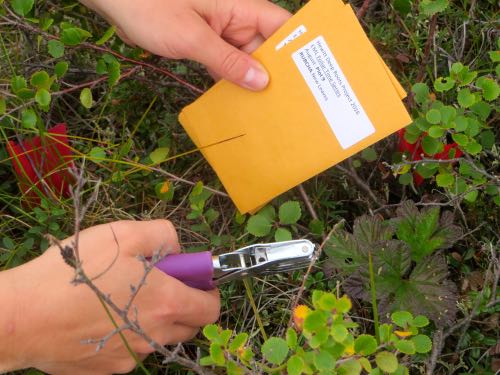Scientists Help Each Other
Today, we worked on a project called "Deep Roots", a project that belongs to Becky Hewitt and Michelle Mack. These scientists are collecting data to understand how plants are responding to a warming tundra. One of their research plots exists on the Gradient Site, the site where CiPEHR's eddy covariance tower is located. Becky asked the CiPEHR team to help them out by collecting plant data from the Gradient site once each month.
Necessary Nitrogen
Nitrogen is an essential element for all life. Plants use nitrogen in the form of ammonia or NH4+ and take up this nutrient through their roots. At the beginning of the growing season, Becky spiked the soil at the permafrost boundary within her research plots with a radioactive isotope of nitrogen, 15N. She then collects samples of the plant material growing within these plots once each month throughout the growing season and takes her plant samples back to the lab to analyze them for the presence of the radioactive isotope. How well the plants take up the radio active nitrogen will give Becky and Michelle an idea of "whether tundra plants can acquire deep permafrost N as soils thaw and whether this influences regional carbon balance." https://www2.nau.edu/macklab-p/wordpress/?page_id=1178
Plant Collection
Emily Romano and the team wobbled across the tussocks to each of 10 plots, which were numbered and marked off by stakes wrapped in pink marking tape, so that each plot could be easily spotted from afar and also identified for each successive field sampling. Each plot was 1 by 1 meter.
As with all scientific research, the scientist closely follows the research protocol. The protocol is brought into the field and referred to often to insure that steps are not left out and procedures are consistent with each sampling.
 Emily Romano refering to Deep Roots Protocol
Emily Romano refering to Deep Roots Protocol
Once the plot has been located, (more wobbling across tussocks) depth to permafrost was measured.
 Emily Romano measuring depth to permafrost
Emily Romano measuring depth to permafrost
Next the team would take 5 leaves from each of 7 different species within the site. For the Rubus species, only a small hole punch sample was taken.
 Punching a hole in Rubus plant leaf
Punching a hole in Rubus plant leaf
The leaves were placed in brown envelopes labelled with date, species name, and a few other data identifiers.
 Emily Romano sorting plant sample envelopes
Emily Romano sorting plant sample envelopes
Once collected, the samples were brought back to the lab and placed in the dehydrator before shipping them off to a lab. At the lab, the samples would be pulverized and digested for radioactive isotope analysis.
 Placing plant samples in dehydrator
Placing plant samples in dehydrator
 Plant samples ready for dehydration
Plant samples ready for dehydration
The dehydrator used is a model that many homeowners might use to dry their fruit. BUT dont try drying your blueberries in this one! A purple mess would be your only reward.

